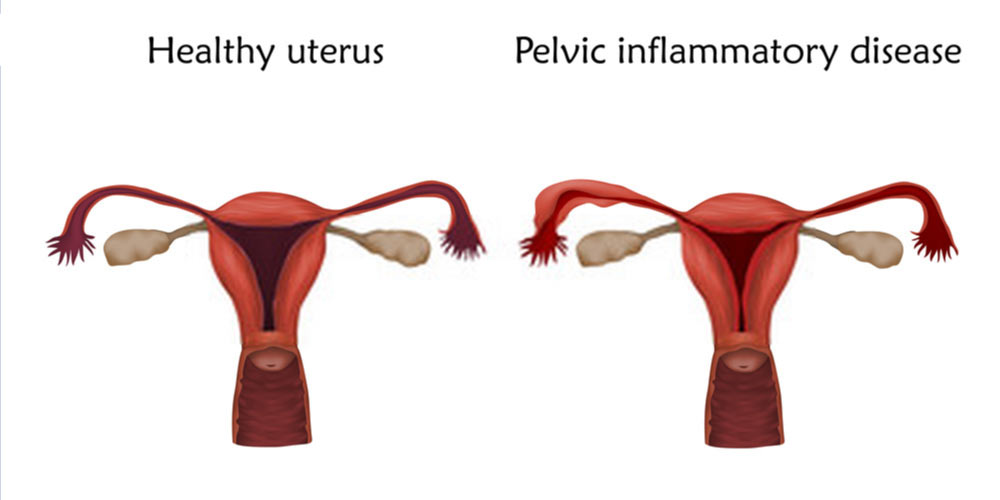
Pelvic inflammatory disease or PID is the infection of the female reproductive organs. The pelvis is located in the lower abdomen and includes fallopian tubes, ovaries, cervix, and uterus.
As per the U.S. Department of Health and Human Services, Pelvic inflammatory disease affects about 5 % of females in the United States.
Many different types of bacteria can cause PID. This also includes the same bacteria that cause the STIs (sexually transmitted infections) gonorrhea and chlamydia. What commonly happens is that the bacteria first enter the vagina and cause an infection. As time passes, the infection can move into the organs of the pelvic region.
PID can become severely dangerous and even life-threatening if the infection spreads to the female’s blood. If you suspect that you may have PID, see your gynecologist as soon as possible.
Table of Contents
Symptoms of pelvic inflammatory disease
The symptoms and warning signs of pelvic inflammatory disease can be mild, making it difficult to recognize. Some females do not have any signs or symptoms of PID. Common noticeable warning signs and symptoms of the pelvic inflammatory disease include-
- Mild to severe pain in the lower abdomen and pelvis
- Abnormal or excessive vaginal discharge with an unpleasant odor
- Abnormal uterine bleeding (AUB), especially during or after sex, or between period cycles
- Painful sexual intercourse
- Fever
- Chills
- Painful urination
- Frequent urge to urinate
Causes of Pelvic Inflammatory Disease

Several types of bacteria can cause PID. But, common STIs – gonorrhea or chlamydia infections are the most common to cause pelvic inflammatory disease. Usually, these bacteria are acquired during unprotected sexual intercourse.
Less commonly, the bacteria can enter the reproductive tract anytime the normal barrier created by the cervix is disturbed. This can commonly happen during periods and after childbirth, miscarriage, or an abortion. Rarely, bacteria can also enter the reproductive tract at the time of insertion of an IUD (intrauterine device) or any other medical procedure involving the insertion of instruments into the uterus.
Also Read- Beginner’s guide to Emergency Contraceptions
Risk factors
Many factors might increase a female’s risk of pelvic inflammatory disease, including:
- Being sexually active before 25 years of age
- Having a sexual partner who has multiple sex partners
- Having multiple sexual partners
- Having unprotected sex
- Douching
- Having a history of PID or sexually transmitted infections
There is a slightly increased risk of pelvic inflammatory disease after the female has an IUD (intrauterine device). This risk is generally limited to the first 3 weeks after insertion.
Also Read- How sexual activities can affect vaginal health
The long-term outlook of pelvic inflammatory disease

Pelvic inflammatory disease is a highly treatable condition and most females make a full recovery after treatment of PID.
However, according to the CDC (Centers for Disease Control and Prevention), about 1 in 8 females with a history of PID have difficulty getting pregnant. But, pregnancy is still possible for most females with the help of a doctor.
Source– http://www.cdc.gov/std/pid/stdfact-pid.htm
Prevention
In order to reduce your risk of PID, it is suggested to do the following-
- Practice safe sex- Avoid unprotected sex and use condoms for sexual intercourse and limit your sexual partners.
- Talk to your gynecologist about contraception- Many types of contraception do not protect against the development of the pelvic inflammatory disease. Using barrier methods, like condoms, helps to reduce the risk of PID. Even if a female takes birth control pills, she should use a condom every time she has sex with a new partner to protect against STIs.
- Get tested- If you are at risk of an STI, visit your doctor for testing.
- Get your partner tested- If you have PID or an STI, advise your partner to be tested to prevent the spread of STIs and also your possible recurrence of PID.
- Do not douche- Douching can upset the pH and bacteria balance in your vagina, increasing the risk of PID.
When to see a gynecologist
See your gynecologist and seek urgent medical care if you experience any of the following signs-
- Severe pain low in the abdomen
- Severe nausea and vomiting with the inability to keep anything down
- Fever, with a temperature higher than 38.3 C
- Foul smelly vaginal discharge
If you have signs and symptoms of PID that are not severe, still see your gynecologist as soon as possible. Smelly vaginal discharge, painful urination or vaginal bleeding between period cycles can also be symptoms of an STI (sexually transmitted infection).
If the above-mentioned symptoms occur, stop sexual intercourse and other activities and see your gynecologist soon. Proper and timely treatment of STI can help prevent PID.
Need to speak to a doctor? Consult the best doctors online right away! Click here to connect with a doctor.
Also Read- How to keep your vagina healthy after sex?







